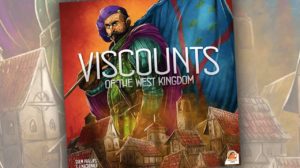A Very Brief History of Flight
In 1903, the Wright Brothers (William and Orville) achieved “first in flight” with a flight of 12 seconds covering 120 feet. That’s a shorter distance than an American football field…from side to side. It was the first documented controlled, sustained flight of a powered, heavier-than-air aircraft in history. Less than 5 years later, Wilbur Wright would win the very first Michelin Cup with a flight of 77.5 miles. Quite an improvement from a paltry 120 feet!

A little over 10 years after that famous first flight, in 1914, the first successful commercial flight was flown. Consisting of the pilot, Tony Jannus, and a single passenger, the flight took off from St. Petersburg, Florida in a craft manufactured by Thomas Benoist and touched down in Tampa, Florida 23 minutes later, a distance of about 17 miles.

For the longest time, prop-driven planes reigned supreme. It wasn’t until the invention of the first jet aircraft in 1939, a quarter of a century later, before innovation in aviation would see its next big bump.
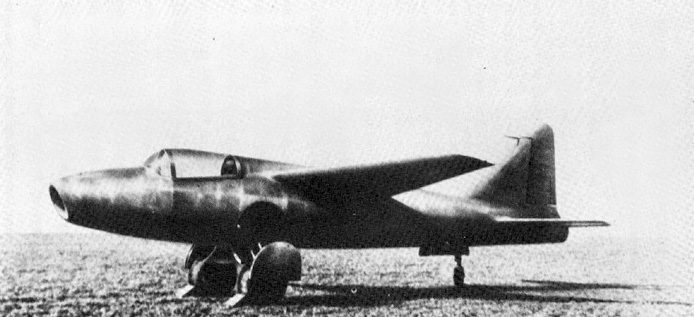
Designed by Ernt Heinkel, that aircraft, the Heinkel He 178, received a very lukewarm reception. Nobody at the time realized the full impact of what he’d accomplished. In less than 40 years, aircraft had evolved from cloth and sticks tied together with wire to devastating weapons of war manufactured in factories from sheets of aluminum and steel.
Nobody in 1939, and certainly nobody in 1903, could have imagined the world we live in today where our skies are constantly abuzz with the sound of airliners passing overhead loaded with passengers. In fact, it is estimated that there are half a million people in the sky at any given time of day. In less than 36 years (that’s less time than what elapsed between the release of Pong to the launch of the Playstation 2), what began as a dream of just getting off of the ground has turned into a multi-billion dollar industry. We didn’t just make it to the skies. We dominated them.
Overview
First in Flight takes place during those early years of aviation when getting off the ground was still just a dream. Players take on the roles of famous aviators of the time as they compete to become the most famous aviators of all. In addition to the famous Wright Brothers, players will be introduced to other aviators of the time such as Thérèse Peltier (who is believed to have been the first female passenger on a plane and possibly even the first female to have piloted one) and Shivkar Bāpuji Talpade (who some believe achieved what the Wright Brothers achieved—albeit, without a pilot at the controls—in India in 1895 even though there is no known documentation of the feat).
Taking place over the course of four years, First in Flight features a smattering of deck-building with a whole heaping serving of press-your-luck. Governed by a time track (one of my favorite mechanisms), players take turns moving their aviators from one action space to the next in an effort to improve their deck (which governs how far they can fly), acquire new technologies to make their efforts at flying more efficient, gain friends who provide their support in the form of unique abilities, and fill their coffers with money. The first person to move their Flight Record Tracker beyond 36 on the score track will trigger the end of the game. And once the game has come to an end, the player who pulled off the longest sustained flight will be declared the winner.
Of course, this is a high-level overview of the game. If you’re just interested in reading what I think about the game, then feel free to skip ahead to the Thoughts section. Otherwise, read on as we talk about how to play a game of First in Flight.
Pre-Flight Check
A game of First in Flight is set up like this:

Each player chooses a color and takes the matching Pilot pawn and Flight Record Tracker along with a Player mat and a Descend card. Place the game board between the players where they will place their Pilot pawns, in random order, onto the starting area spaces. Their Flight Record Trackers are placed at the start of the Flight Record track.
The Glide, Experience, and Basic Flyer Problem card decks are set close by in face up piles. Each of the remaining card types is shuffled to form a deck and these are placed face down next to the other cards. Two cards are drawn from the Friend and Technology card decks and placed face up next to their respective decks. The same is done with the Skill Card deck, except four cards are drawn. Along with two randomly drawn Design Flaw cards each player receives two Basic Flyer, one Experience, and four Glide cards. These are shuffled together to form a face down Flight deck which is then set atop the barn space on the Player mat. Then, a number of Pilot cards are drawn and the players take turns, in reverse turn order, selecting a Pilot to take. The selected Pilot is placed atop the plane image on the Player mat. Finally, the players each receive some starting money based on their position in turn order.
Then you’re ready to begin.
What Goes Up…
First in Flight is played over the course of four years. In game terms, a year is defined as a single traversal of the time track. The time track is divided into a series of worker placement spots occasionally interspersed with some stopwatch icons. Players take turns moving their Pilot pawns around the track, always beginning with whoever is furthest behind, taking actions until they are forced to (or decide to) leapfrog ahead of another player at which point it becomes the turn of whichever player is then at the back of the pack. Once a player reaches the end of the time track, they are done for the round. Once every player has reached the end, the year is over, some cleanup is performed, and players begin taking their actions for the new year unless the fourth year was the year just completed. If that’s the case, the game comes to an end.
If it isn’t the end of the fourth year, in addition to refreshing the card offerings, the Michelin Cup prizes are awarded to the players. The player who is furthest along on the Flight Record track will receive $8. Second place receives $6. Everyone else receives $4.
There are a total of eight actions to choose from with each appearing multiple times along the track: Friend or Technology card, Skill card, Experience card, Funding, Upgrade, Fly, and Repair.
The Friend or Technology card and Skill card actions are collectively referred to as “Development card” actions and they work the same. Pay $3 (or $2 if you’ve become famous—more on this later) and take one of the face up cards OR take one card from the top of the appropriate deck. Any cards that get removed are not refilled until the end of the year during cleanup.
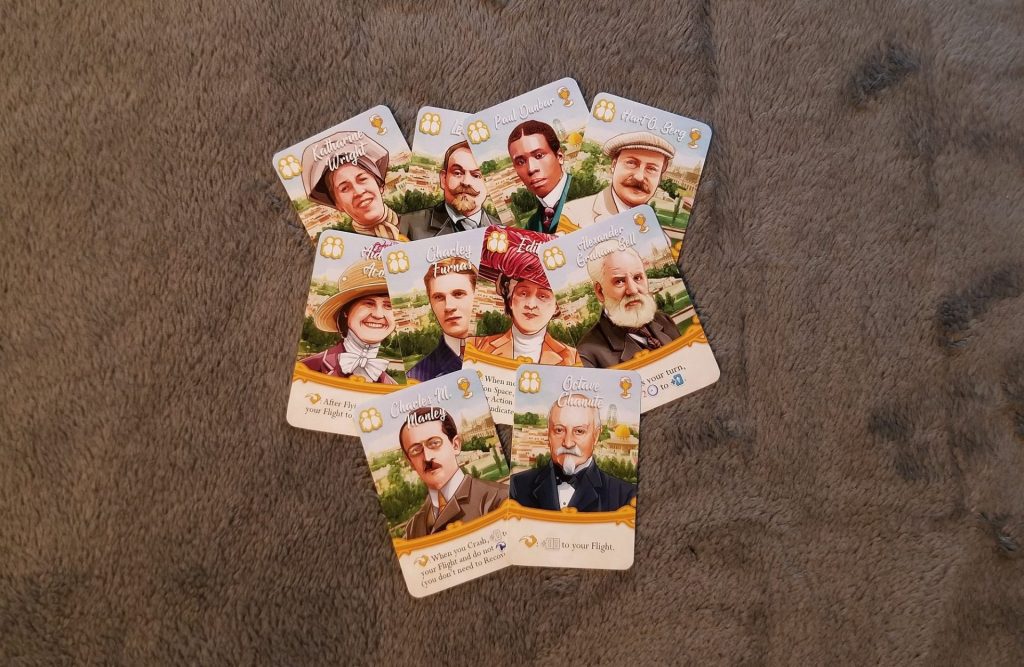
The Experience card action involves you adding an Experience card from the face up supply to your face down Flight deck. This action costs either $3 or moving your Pilot pawn ahead on the time track a total of two time segments (two stop watches from its current position).
Taking the Funding action rewards you with $5.
When taking the Upgrade action, choose an amount to pay in either time or money (with a minimum of two). Then draw that many cards from the top of the face down Upgrade card deck, select two to keep, and shuffle the unselected cards back into the deck. The cards you keep are added to your Flight deck. You must also add one card drawn from the Design Flaw deck to your Flight deck as well.
The other two actions, Fly and Repair, are closely related. This is where your deck building efforts will bear fruit. Understanding these concepts is of such tantamount importance, in fact, that I’m going to give them their own section.
…Must Come Down
Flying in First in Flight is a game of push-your-luck chance in which your goal is to beat your previous record and hopefully everyone else’s as well. And, if all goes right, you’ll pull it off without crashing.
Here’s how it works:
If you take the Fly action, you will first shuffle your Flight deck and then start drawing and playing cards face up in front of you one at a time. Each card will add some distance to your flight. At the beginning of the game, your deck will mostly consist of generic Glide cards which add one distance each. As time goes on, you’ll be adding Upgrade cards which will add two, three, four or five each. If a Research card is drawn, in addition to it adding one to your flight, it will also allow you to draw a Glide card from the Glide card deck and add it to your flight as well.
This is the easy part.
But, inevitably, at some point you will begin encountering problems. These come in the form of Basic Flyer Problem and Design Flaw cards. The Basic Flyer Problem cards add an angry red emergency icon to your flight and the Design Flaw cards add two each. If you ever reach or exceed four of these icons during your flight, then you crash. Crashing isn’t terrible, but it isn’t preferable either. A crashed Pilot pawn is laid on its side and its owner must spend their entire next turn spending two time segments to set it upright again. This is referred to as the Recover action.
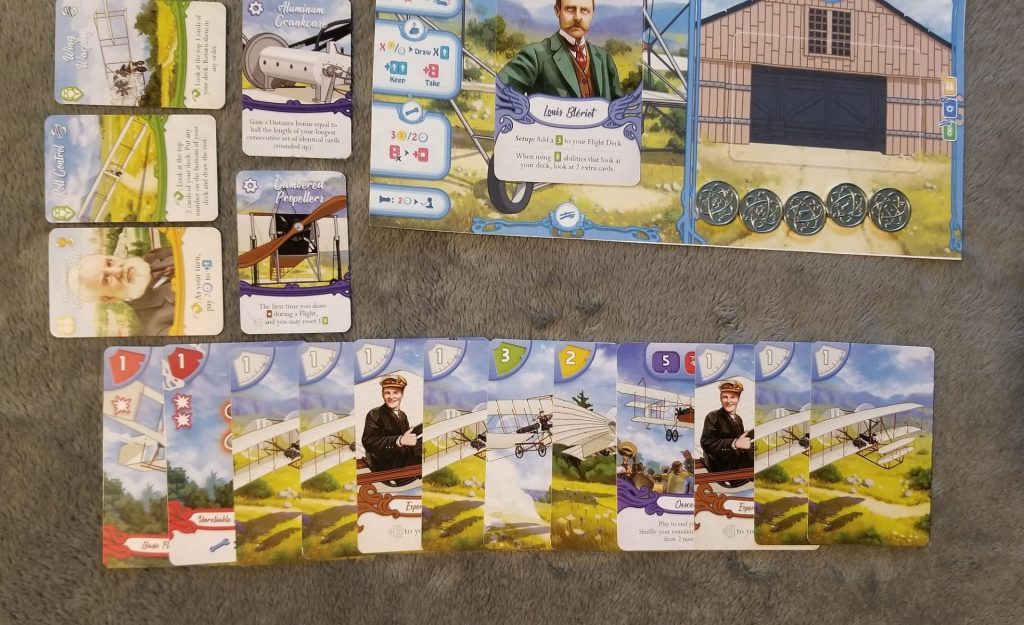
At any point during your flight, prior to crashing, you have the option to use your Descend card. If you have any Skill cards, they must be used prior to using it. After using your Descend card, you will then shuffle the remainder of your Flight deck and then draw the next two cards and add them to your flight. If luck is on your side, you will end your flight without crashing. If that is the case, the Descend card will add an extra five to your distance. Otherwise, it only adds two.
Whether or not you crashed, you will always earn your total distance (some Friend or Technology cards may extend your distance even more!). If that distance is greater than where your Flight Record Tracker currently sits, then move it to the new distance record you’ve set. Once you reach the fifteen distance mark, you become “famous” and will receive a monetary discount on some of the actions on the time track.
After Flying, gather up all of the cards in your Flight deck, minus any Design Flaws you may have uncovered during your flight, and place them face down in a deck on top of the barn on your Player mat. Any Design Flaws that were set aside are placed on top of the deck face up so that they are available for the final action: Repair.
When you take the Repair action, you will pay either $3 or two time segments and then select one of your face up Design Flaw cards to remove from the game and replace with a Basic Flyer Problem card. Each Design Flaw card has a special action that fires off when it is Repaired. For instance, Repairing a Power Failure card will earn you an Upgrade card drawn from the Upgrade card deck.
The first player to reach the 36 mark triggers the end of the game at which point every one, including that player, gets one final flight. The person with the longest distance record after this final flight wins the game.
Thoughts
In the 50 years following the end of America’s civil war, the world entered into a new industrial revolution. Not since the Renaissance had the world seen such a rapid proliferation of new inventions and new technologies: the typewriter in 1867, the vacuum cleaner in 1869, the light bulb in 1879, the ballpoint pen in 1888, the radio in 1893, the gas turbine in 1899, the radar in 1904, plastic in 1905, radio broadcasting in 1906, and the Ford Model-T in 1908 to name a few. It was a period of optimistic experimentation, the very embodiment of the ideal that hard work plus determination equals success.
As a child growing up in the 80s, this period of the world’s history fascinated me. Sitting in front of my Lite-Brite, it was hard for me to believe that anyone had ever existed without light bulbs. Riding in the backseat of our old car on the way to see the animatronic Santa’s Workshop display at the mall downtown, it was difficult to fathom that anyone had ever gotten by without a car, much less the department store Santa Claus. And I definitely couldn’t imagine ever going through life without “Girls Just Wanna’ Have Fun” blasting out of the radio.
These were things I thought about often.
I was a curious kid, my nose always buried in a book. I gobbled up knowledge like Augustus Gloop devoured chocolates. I couldn’t get enough. And the one subject that fascinated me more than anything else was the history of aviation. There was just something about the thought of flying up into the atmosphere, the wind whipping through my hair, being able to reach out and touch the clouds that captured my imagination like nothing else.
Thus it was that when I was offered a chance to preview First in Flight that I leapt at the opportunity. Seeing Amelia Sales’s amazing cover illustration reignited a fire within me that had laid dormant for far too long. It took me back to a time in my childhood, geeking out over the Wright Brothers with my friend Chris, climbing onto his roof to throw off gliders we’d constructed. We were more than just two best friends obsessed with building the perfect gliders. We were aviators that were going to change the world.
And I’m glad to say that First in Flight captures that feeling brilliantly. It puts you in the frame of mind of one of those early aviators where every attempt to get off of the ground was one step closer to being the first person in the history of the universe to have ever done such a thing. And, simultaneously, each attempt to get off of the ground was one frightening step away from cataclysmic failure.
First in Flight pulls this off in a way that is equal parts entertaining, invigorating, and educational. Like the rudders, pulleys, gears, levers, and wings of an airplane are all equally important parts of the overall whole so, too, is every action location on the time track as important to the overall game as a whole. Each is just as desirable as the others. And deciding which ones to take and when to take them is rarely an easy choice.
There’s no way to win without Flying, so should you skip ahead and take that action? Doing so will definitely increase your chances at winning the Michelin Cup at the end of the year and that extra cash is always welcome. However, it will also mean that your opponents could take several turns in a row. So maybe you should take it slow. But if you take it slow, then your opponents might decide to surge ahead and take the spot you were ultimately hoping to take. It’s fun to try to outthink and outmaneuver your opponents and it’s always pleasing when you’re able to manipulate things in such a way that you are able to take several turns in a row.
But, for me, the most fun is derived from performing a flight. The tension that comes from flipping over the cards of your Flight deck is delicious. It becomes particularly intense when you’re just one or two away from exceeding your previous record but you’ve already uncovered some flaws. In those instances, it comes down to a couple of random card flips. You’ll find yourself praying to whatever deities are listening that you don’t crash. I can imagine this is what those first aviators must have felt when, despite all expectations, their flyers actually took off from the ground. Would they land successfully or was this the last thing they were ever going to do?
Another thing that I really appreciate about First in Flight is the diversity represented by the characters on the cards. I will admit, I don’t know who all of these folks are and I had to do a lot of Wikipedia’ing to write about the ones that I did. But you’re in luck. You might not have to do the same because, according to my discussions with the publisher, there’s a very good chance these details will be included within the game itself similar to how the character cards are treated in Lewis & Clark or On the Origin of the Species with an Appendix in the back of the rule book detailing each character’s abilities as well as providing a brief snippet about their historical relevance. I certainly hope this makes it in because I absolutely love that kind of thing in games like this.
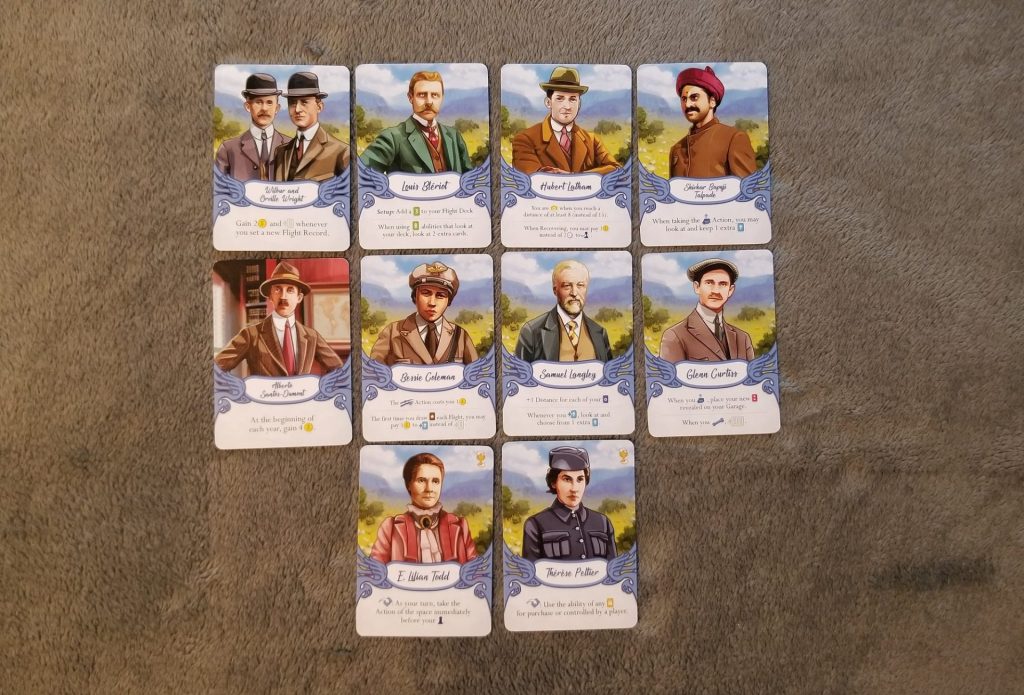
And speaking of things that aren’t in the current rule book, there’s also going to be a solitaire mode included. While the specific rules haven’t been sorted out yet, I gather that the solitaire mode is going to have the player operating a couple of random AIs in a “beat the AI and/or your previous final score” type of scenario. I wish I could comment on it more but as of this writing, unlike your flyer, the solitaire mode is still up in the air.
In closing, First in Flight is pretty spectacular and it’s a game I look forward to playing again soon.






